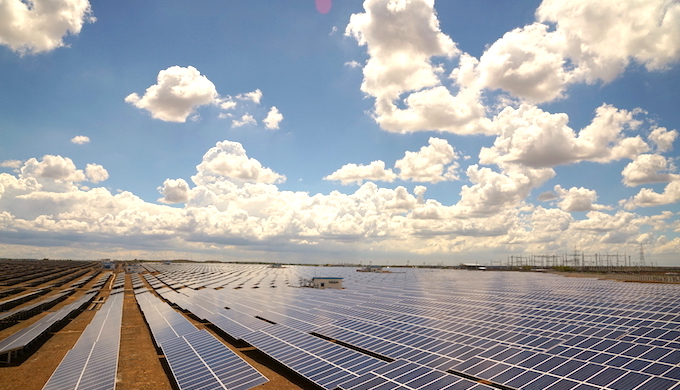For remote areas and villages across India which lack grid connectivity, solar power generation has been a huge boon. A plant at Baramati in Maharashtra, which powers 24 million households and will continue to do so for the next 25 years, is one such instance

Solar plant at Baramati in Maharashtra (Image by Welspun Renewables)
The Maharashtra state cabinet which recently sanctioned Rs 2,682 crore ($403 million) to promote renewable energy in the next five years also stressed on promoting the use of solar energy in various sectors. Additionally, it approved subsidies for generation of solar energy. By 2022, Maharashtra will have to achieve an installed capacity of 12,611 MW from the current 378.7 MW. Maharashtra is now looking to join the solar capacity expansion race.
However, even before the state government’s policy on solar, it was the Baramati 52 MW (DC) project which made news, since it was the first to be set up under the Public-Private Partnership (PPP) model with the Maharashtra State Power Generation Co. Ltd (Mahagenco). Vineet Mittal, Vice-Chairman, Welspun Renewables, says, “Prior to this, only large scale infrastructure projects like roadways, ports etc. were commissioned under this model.” He feels the project’s successful commissioning has paved the way for more solar projects to be developed under the PPP mode. Welspun Renewables is the private partner in the project.
For the next 25 years, this plant is expected to generate enough green energy to power 24 million households. Awarded the “Solar Project of the Year 2015” at the 5th Global Solar EPC Summit, an estimated 83,220 tons of carbon dioxide emissions will be avoided by this project every year.
Earlier, most classrooms in this region lacked tables and benches. Now these have been made from the wooden pallets in which the solar modules were packed.
Welspun Renewables is now looking to expand in Maharashtra. Mittal says, “We have been participating in various bids that have been coming up and consequently our capacities are either under development or in advanced stages of construction.”
Sunlight ahead
“Setting up large scale projects is beneficial for developers as it allows economies of scale and better profitability,” says Mittal. The government’s announcement of providing 15% subsidy to the private sector for setting up solar power units is a welcome move too.
There are some incentives he wants:
- Exempt renewable energy (RE) from Goods and Services Tax (GST)
- Address the Infrastructure Investment Trust (InvIT) structure to provide a long term financial solution for the ailing infrastructure sector
- Similar treatment for capital gains in the InvIT regime as in the case of initial public offerings (IPO). This will be an incentive to raise long term funds
- Remove Minimum Alternate Tax (MAT) from capital gains arising on exchange of shares of special purpose vehicles (SPV) for InvIT units
- Reduce the qualifying period for long term capital gains from 36 months to 12, to bring parity between listed units of business trusts and equity shares in respect of taxability of capital gains
- InvITs should not be denied d. Dividend Distribution Tax: exemption on distribution by SPVs
- Tax exemption should be extended to the gains from sale of shares of the SPVs or the sale of assets
- Remove withholding tax, which is now 10% for residents and 5% for non-residents
- Increase leverage for InvIT assets to 75% from the current 49%
- Raise limit for investment in development assets to at least 25% of the InvIT assets from the current 10%
- Make solar energy a priority sector and exclude it from the conventional power sector with a different sectoral cap, so that banks are encouraged to lend to the sector.
- Ensure payment security: Given the financial health of state-run power distribution companies (DISCOMs), default in payment to developers is seen as a critical risk by financial institutions. It is necessary to take constructive steps for allaying the fears of the bankers and ensure investments in the sector.
- The government should provide full payment guarantee, so that more lenders enter the solar energy sector
- Insurance firms should be allowed to reinsure payment security. Swiss Re and Zurich provide payment security, but the Indian government does not allow them to sell their product directly and Indian insurance companies have not pursued this
- The government should allow the Multilateral Investment Guarantee Agency (MIGA) to provide payment security. Currently, MIGA can only insure foreign companies’ exposure in India
- The project development cycle of solar power projects is 6-8 months. When the projects are ready to be commissioned, the corresponding power evacuation architecture often lags behind. State governments should develop evacuation architecture beforehand and this should get priority lending status
- Land availability has been the biggest challenge for solar projects. state governments should create land banks and exempt the projects from agriculture to non-agriculture use charges, since this is a non-polluting industry
- Renewable Purchase Obligations (RPO) should be made enforceable for all
- The Renewable Generation Obligation should be scrapped
- The clearance system for solar power projects should be simplified, and it should not be necessary to get consent from State Pollution Control Boards.
(The trip of Sapna Gopal to the Baramati plant was sponsored by Welspun Renewables)
